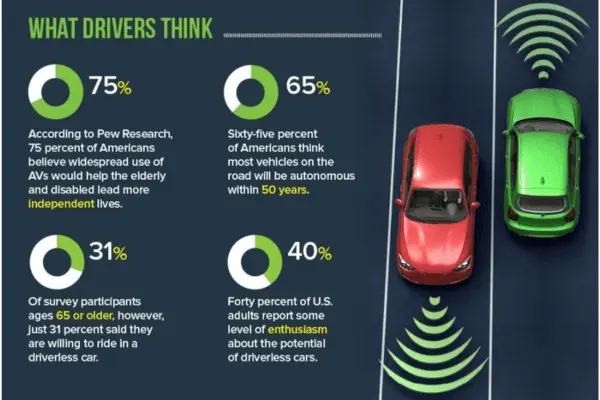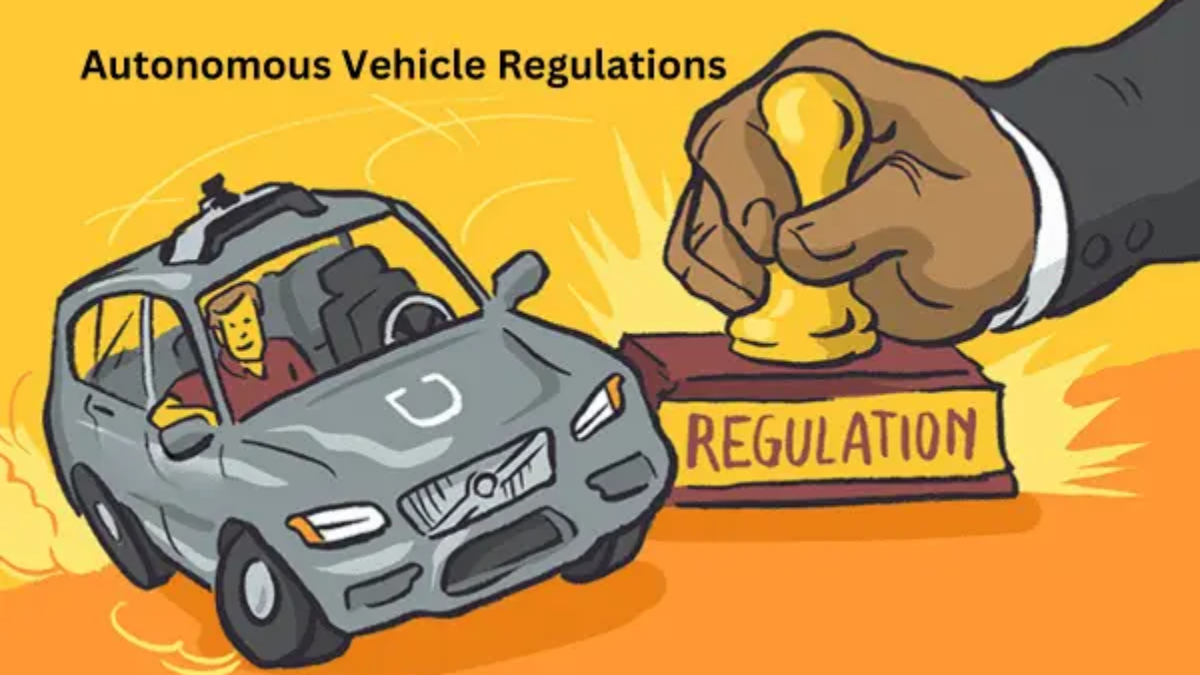Introduction
Autonomous vehicles (AVs), sometimes known as driverless or self-driving automobiles, are a revolutionary development in transportation technology. They have the potential to improve mobility for the elderly and disabled, lessen traffic, and increase road safety. However, in order to fully reap these advantages, strong regulatory frameworks that oversee the safe development, testing, and deployment of Autonomous Vehicle Regulations must be established in addition to technological improvements.
Autonomous Vehicle Regulations are developing legal frameworks designed to handle the many issues raised by this game-changing technology. These include worries about infrastructure preparedness, public trust, safety, liability, and data privacy. Governments everywhere are taking proactive steps to create laws that guarantee AVs are incorporated into society in a way that is inclusive, moral, and safe.
Important Features of Laws Governing Autonomous Vehicle Regulations

1. Safety Rules
Safety is the cornerstone of rules governing autonomous cars. Ensuring that autonomous vehicles operate as safely as human drivers, if not safer, is the main goal of any legislation. To achieve this, governments and regulatory agencies have set strict safety guidelines that include:
2. Sensor and perception systems:
Autonomous Vehicle Regulations evaluate AVs’ precision in detecting and interpreting pedestrians, other vehicles, and road conditions.
3. Algorithms for making decisions:
Legal frameworks require that AI-driven systems be validated to make sure they can manage intricate driving situations and edge circumstances.
4. Fail-safe mechanisms:
To prevent accidents in the event of a system failure, requirements for emergency controls and redundant systems are frequently imposed.
Regulators hope to reduce the hazards associated with hardware failures, software bugs, and erratic road conditions by implementing such standards. The focus on safety also increases public trust, which is essential for AV technology to be widely adopted.
5. Protocols for Testing and Deployment
There are strict Autonomous Vehicle Regulations governing the process from prototype to public deployment. Before testing AVs on public roadways, developers must secure specific licenses or permits. Usually, these permits include:
1. Limited testing areas: Early tests are frequently limited to designated routes or geofenced locations.
2. Remote control and monitoring: Even during autonomous testing, several jurisdictions demand human supervision.
3. Data submission: Testers are required to provide frequent reports on occurrences, technical problems, and vehicle performance.
Deployment regulations raise these requirements, which call for thorough safety evaluations and practical validation. By ensuring that AVs are progressively exposed to intricate driving situations, this tiered approach enables regulators to methodically detect and reduce dangers.
6. Information Gathering and Reporting
Large amounts of operational data, such as event logs, route history, and sensory input, are produced by autonomous cars. Regulatory structures frequently require:
1. Constant data logging: AVs need to document system actions, choices, and interactions with the surroundings.
2. Reporting incidents: Any mishap or irregularity needs to be noted and reported to the appropriate authorities.
3. Transparency protocols: Regulators must have access to some data so they can independently review it.
Performance monitoring, forensic analysis in the event of an accident, and future policy improvements are all made possible by this data. Public monitoring and accountability are also strengthened by regulations that place a strong emphasis on data disclosure.
7. Frameworks for Liability and Insurance
One of the most difficult regulatory problems in AV deployment is figuring out who is to blame for an accident. Driver-responsibility-based traditional paradigms are no longer adequate. Regulations currently aim to:
1. Assign blame: The manufacturer of the vehicle, the software developer, or even the operator of the infrastructure may be held liable, depending on the circumstances.
2. Encourage new insurance models: Laws are being revised to take into account no-fault insurance models and product liability frameworks.
3. Process claims more easily: Having clear policies helps victims get paid quickly and deters lawsuits.
The goal of these frameworks is to provide an open legal system in which each party is aware of their rights and responsibilities.
8. Cybersecurity and Privacy
Privacy becomes a crucial regulatory concern as AVs gather vast amounts of data, such as location history, biometric information, and real-time surroundings. Important prerequisites consist of:
- Data minimization: We should gather only information that is absolutely necessary.
- Safe storage: Encrypted data must be kept in a secure location.
- Controlled access: Only authorized individuals or organizations should have access to sensitive data.
- Approval from users: Data practices must inform owners and passengers, who must give their approval.
To prevent threats from compromising AVs and to guarantee the integrity of vehicle operations, we also need strong cybersecurity standards. By prioritizing privacy, we align AV development with more general digital rights standards and increase consumer trust.
9. Inclusivity and Accessibility
For marginalized populations, especially those with disabilities or restricted access to transportation, autonomous cars have the potential to completely transform mobility. The demands of regulations are increasing:
- Features that comply with the Americans with Disabilities Act (ADA) in the United States are one example of compliance with accessibility standards.
- Voice control, tactile feedback, and visual help for people with disabilities are examples of user interface adjustments.
- Universal design principles: From the beginning, vehicles should be useful by a wide variety of users.
- Regulations that require inclusion make sure that AV technology benefits all facets of society equally.
10. Infrastructure Readiness
Supportive infrastructure plays a major role in AV implementation. Frameworks for regulations may include:
- High-definition mapping: They standardize and update AV navigation maps often.
- Roadway sensors and communication: Real-time data sharing via vehicle-to-infrastructure (V2I) systems.
- Upgrades to traffic and signs include AV-compatible signage and smart signals.
- In order to modify public areas for AV integration, cooperation between urban planners and transportation authorities is essential.
Benefits of Autonomous Vehicle Regulations

The following are some advantages of Autonomous Vehicle Regulations that encourage responsible innovation and implementation:
1. Increased Security
Regulations assist avoid accidents and lower the number of fatalities by requiring strict testing and safety procedures. They lessen dependency on unproven systems and establish a benchmark for acceptable AV performance.
2. Consistency and Standardization
Developers and manufacturers have an even playing field because to uniform laws. Global standardization can simplify compliance and hasten the deployment of cross-border antivirus software.
3. Legal Clarity and Accountability
In the event of an accident, clear liability regulations eliminate doubt and guarantee that those at fault are held accountable. Consequently, this clarity supports fair insurance practices and legal adjudication.
4. Improvements Driven by Data
Moreover, mandatory data collecting enables continuous learning and improvement. As a result, engineers and policymakers are able to pinpoint persistent problems, create fixes, and modify safety regulations over time.
5. Acceptance and Trust by the Public
When people believe that someone is closely watching AVs, they are more likely to embrace and use them. Transparency in regulations calms the public and allays concerns about job displacement or safety.
6. Assurance of Privacy and Cybersecurity
Laws that protect user data and stop cyberattacks enhance trust and sustained user involvement. They also stop the misuse of private information.
7. Innovation in Balance
Clear bounds provided by regulations safeguard the public interest while permitting technical innovation. This balance encourages moral and environmentally friendly innovation.
8. Inclusion and Social Equity
Additionally, regulations guarantee that AVs serve everyone, not just a chosen few, by mandating accessibility features. Consequently, this all-inclusive strategy lessens mobility inequalities in society.
The difficulties and disadvantages of AV regulations

Notwithstanding the advantages, there are significant regulatory obstacles:
1. Excessive regulation
However, regulations that are too onerous may discourage new ventures or hinder innovation. Indeed, a thin line separates bureaucratic burden from safety assurance.
2. Expensive Compliance
In addition, the financial and technological challenges of complying with regulations may be too much for small enterprises to handle. As a consequence, these expenses may also lead to higher consumer pricing.
3. Insufficient Worldwide Uniformity
Furthermore, disparate national standards make international deployment more difficult. Consequently, manufacturers must modify vehicles for every jurisdiction, which raises both the cost and complexity.
4. Lag in Regulation
Moreover, legislation frequently lags behind technological advancements. As a result, older legislation may not adequately address emerging hazards or may even impede the implementation of innovative features.
5. Slow Deployment and Testing
However, intricate permit procedures and reporting requirements may delay testing schedules. Therefore, for timely innovation, we must streamline regulatory processes.
6. Problems with Interoperability
AVs created in accordance with one set of rules might not work properly in another, which could provide inconsistent user experiences or safety issues.
7. Overhead in Administration
Administrative difficulties arise from stringent reporting and paperwork requirements, particularly for regulators and companies with little funding.
8. Insufficient Liability Coverage
The current legal frameworks may not provide sufficient coverage for complex scenarios such as mixed-fault collisions involving both human and autonomous drivers. Liability models require more specificity.
Conclusion
Autonomous Vehicle Regulations will have a major role in determining how people move in the future. Regulations offer the framework for the development of safe, inclusive, and effective transportation systems as AV technology advances. The proper legal frameworks can unleash the full potential of AVs, from improving road safety and protecting data privacy to encouraging innovation and advancing accessibility.
Governments, IT companies, civil society, and the general public must, however, continue to communicate and work together on this project. Regulations need to be flexible, progressive, and grounded in practical knowledge. We can only create a transportation system that genuinely meets the requirements of everyone—safely, morally, and sustainably—by taking such a cooperative and adaptable approach.
As we approach a new era in mobility, careful and proactive regulation will be essential to advancing the field while preserving the interests of the public. The development of autonomous vehicles is about building a better, more connected world, not just about advancing technology.


